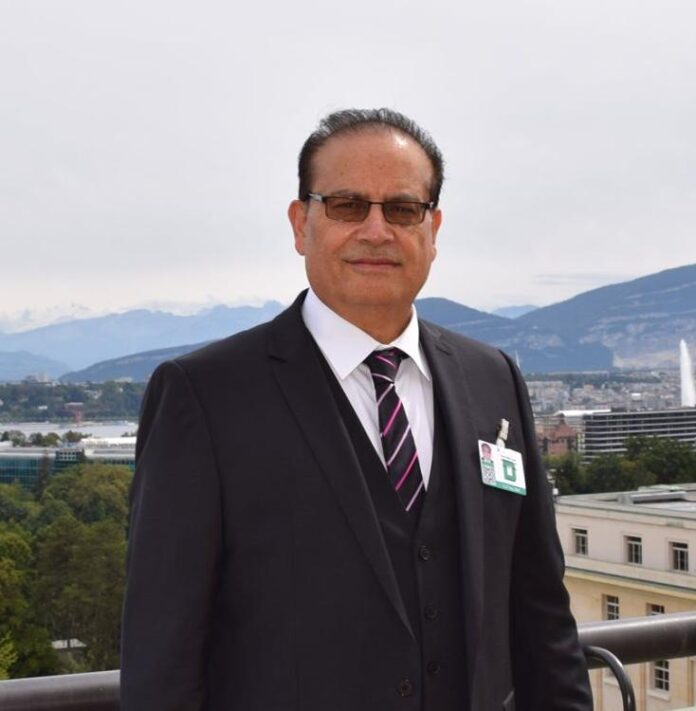By Qamar Bashir
In a stunning turn of events, President Donald J. Trump announced the official end of the “12-Day War” between Iran and Israel. The phased ceasefire, declared on Truth Social on June 23, 2025, would see Iran begin de-escalation, followed by Israel, culminating in what Trump called the “Official END” of the war.
Behind this terse announcement lay one of the most revealing and consequential geopolitical clashes of recent history. The war, ignited by Israeli airstrikes on Iranian nuclear infrastructure and escalated by U.S. intervention, has exposed not only the raw realities of regional power dynamics but also the shifting sands of global influence, public sentiment, and military doctrine.
The ceasefire followed Iran’s retaliatory missile barrage on the U.S. Al Udeid Air Base in Qatar, launched in response to one of the most complex aerial operations in U.S. military history. Under the codename “Operation Midnight Hammer,” seven B-2 Spirit stealth bombers flew nonstop from Whiteman AFB in Missouri and dropped 14 GBU‑57 Massive Ordnance Penetrators (MOPs)—12 on Fordow, 2 on Natanz. In parallel, 30 Tomahawk cruise missiles launched from a U.S. submarine struck Isfahan and Natanz.
Despite the sheer scale of the operation, no radiation leaks were detected, and no nuclear chain reactions occurred. Iran had removed its enriched uranium and sensitive material in anticipation—preserving the core of its nuclear program.
More importantly, what the U.S. and Israel failed to eliminate was Iran’s greatest weapon: its people. Its nuclear scientists, engineers, military technologists, and program strategists remain intact—capable of reconstructing, duplicating, and scaling its entire nuclear infrastructure. This war demonstrated that it is not the bunkers or centrifuges, but the brains behind them that constitute true power. And Iran’s brain trust remains fully functional, resilient, and determined.
The war also shifted the center of global deterrence doctrine. Though three nuclear powers were engaged—Israel, the U.S., and Iran—no nuclear weapons were used. The war proved that conventional capabilities, when sufficiently advanced and precise, can inflict comparable strategic damage. Iran demonstrated that with calibrated missile strikes and asymmetric warfare tools, it can render massive psychological and structural impact—without nuclear escalation.
This pattern echoes other conflict zones. Russia’s invasion of Ukraine has not yet crossed the nuclear threshold, despite nuclear posturing. Pakistan and India, both nuclear states, also engaged in recent hostilities with strictly conventional arms. The world appears to be moving from MAD (Mutually Assured Destruction) to a new form of “Minimum Assured Deterrence,” where precision and resilience matter more than nuclear stockpiles.
Meanwhile, Israel’s military supremacy was decisively challenged. Despite its reputation as a fortress state, its inability to strike Iran effectively without U.S. support shattered the myth of unilateral invincibility. Its famed Iron Dome failed under volume fire. Israeli cities were hit, citizens panicked, and for the first time, Israelis experienced the horrors of war on their own soil—something Palestinians have endured for generations.
Israeli Prime Minister Netanyahu, who once aimed to destroy Iran’s nuclear ambitions, now finds himself in a dramatically weakened position. None of the war’s original goals—regime change, program destruction, or surrender—were achieved. Instead, Iran remained standing. Emboldened. And respected.
Yet perhaps one of the most strategically consequential developments was the silence of two global powerhouses—Russia and China. Despite their past support for Iran in regional forums, neither nation intervened militarily. Their inaction raises fundamental questions: Did they lack the appetite for another major conflict? Or was this calculated neutrality a trap to let the United States walk alone into yet another costly, unwinnable war? Either way, their abstention allowed the U.S. to stand isolated, absorb all blame, and risk being drained of prestige, personnel, and power. It was a geopolitical chess move—and Washington played right into it.
And yet, amid all this geopolitical maneuvering, one mysterious development may hold critical significance: the unprecedented, closed-door meeting between President Donald Trump and Pakistan’s Army Chief, Field Marshal Asim Munir. While no formal statement was issued, seasoned analysts suspect the meeting’s true purpose may have been to leverage Pakistan’s trusted relationship with Iran. With no formal diplomatic ties between Washington and Tehran, Trump may have relied on Pakistan’s good offices to convey U.S. intentions, de-escalatory signals, and ceasefire proposals to the Iranian leadership.
Given Pakistan’s historically close ties with Iran and its strategic standing in the Muslim world, it is plausible that Field Marshal Munir acted as a discreet intermediary, articulating Trump’s vision and helping bridge critical gaps. If so, this diplomatic backchannel may have played a decisive—yet still undisclosed—role in securing the ceasefire. In the coming days, more details may surface, shedding light on Pakistan’s quiet but powerful contribution to peace.
Another compelling factor behind Trump’s urgency for de-escalation was Iran’s ability to strike global economic arteries—chief among them, the Strait of Hormuz. With its lethal missiles, fast-attack naval fleets, and proxy militias across the Gulf, Iran was well-positioned to block or severely disrupt this strategic waterway. A closure of Hormuz would have been catastrophic—not only for oil-dependent United States, Europe and China, but for fragile economies such as Pakistan, Lebanon, and much of Africa. A prolonged disruption could have triggered a global recession, skyrocketed energy prices, and collapsed economies. This economic time bomb likely weighed heavily in Trump’s calculus, forcing him to act swiftly to avoid broader international collapse.
Meanwhile, the United States stood alone in this war. The European Union did not support the military intervention. Instead, France, Germany, and the UK pursued diplomacy directly with Tehran. NATO remained entirely absent. This was perhaps the first U.S.-initiated conflict in decades where there was no multinational military backing, no financial burden-sharing, no political cover.
Had this war escalated further, the cost—blood, treasure, and international credibility—would have been shouldered solely by the United States. This realization sent shockwaves through Washington and likely catalyzed Trump’s push for immediate de-escalation.
Iran, though it could not muster active support from either Russia or China or any Muslim-majority country, walks away with a transformed image. No longer the isolated pariah, it is now the country that stood up to two nuclear powers—absorbed their blows, responded proportionally, and survived. Its regional allies—Hezbollah, Houthis, Hamas, and Iraqi militias—are energized. Its population is united. Its sovereignty is intact.
For Israel, the war leaves behind questions. Domestic criticism of Netanyahu has intensified. International confidence in Israeli intelligence and defense has been shaken. And with Gaza still in flames, the question looms: will Israel now finally consider peace, or will it double down on aggression?
Perhaps the most striking outcome of this conflict was the global reaction to the ceasefire. Across the United States and beyond, traditional media, social platforms, and everyday conversations erupted in jubilation. Newsrooms broke the story with celebratory headlines, while TikTok, Instagram, Facebook, and X overflowed with congratulatory messages, reaction videos, and patriotic posts hailing peace. From Chicago and New York to San Francisco and Houston, people took to the streets—not in protest, but in celebration. The American public, who had never fully embraced this war—viewed by many as another foreign entanglement driven by Israel’s geopolitical ambitions—breathed a collective sigh of relief.
Now, Iran is celebrating with pomp, pride, and national dignity, its people and leadership united in a sense of historic triumph. In contrast, Israel is reeling. Its aura of invincibility has been shattered, its claim of superiority undermined. Both its leadership and citizens are left licking their wounds, forced to confront the reality of vulnerability and defeat.
Around the world, peaceful citizens, intellectuals, and thought leaders are hailing this ceasefire as a welcome reprieve. For many, especially in the U.S., Donald Trump is no longer seen as a warmonger but as a peacemaker—first for diffusing tensions between Pakistan and India, and now for halting the Israel–Iran war. A growing chorus now asks: Has Trump earned his place as a Nobel Peace Prize nominee?
This war, though short in days, has altered the trajectory of nations. It shattered illusions, exposed dependencies, challenged assumptions, and—most importantly—proved that a nation’s true power lies not just in bombs, but in brains, unity, and moral courage.
And in this war, Iran had all three.
By Qamar Bashir
Press Secretary to the President (Rtd)
Former Press Minister, Embassy of Pakistan to France
Former MD, SRBC | Macomb, Michigan, USA

















